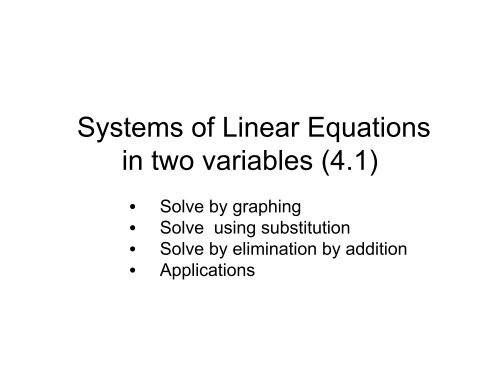Systems of Linear Equations in two variables (4.1) - Bruce E. Shapiro
Systems of Linear Equations in two variables (4.1) - Bruce E. Shapiro Systems of Linear Equations in two variables (4.1) - Bruce E. Shapiro
Systems of Linear Equations in two variables (4.1) • Solve by graphing • Solve using substitution • Solve by elimination by addition • Applications
- Page 2 and 3: Warm-up A restaurant serves two typ
- Page 4 and 5: Solve by graphing 3x + 5y = -9 x+ 4
- Page 6 and 7: Method of Substitution 2x + 3 = y x
- Page 8 and 9: Terminology: • A consistent linea
- Page 10 and 11: Elimination by Addition S:
- Page 12 and 13: Applications A man walks at a rate
<strong>Systems</strong> <strong>of</strong> <strong>L<strong>in</strong>ear</strong> <strong>Equations</strong><br />
<strong>in</strong> <strong>two</strong> <strong>variables</strong> (<strong>4.1</strong>)<br />
• Solve by graph<strong>in</strong>g<br />
• Solve us<strong>in</strong>g substitution<br />
• Solve by elim<strong>in</strong>ation by addition<br />
• Applications
Warm-up<br />
A restaurant serves <strong>two</strong> types <strong>of</strong> fish d<strong>in</strong>nerssmall<br />
for $5.99 each and a large order for $8.99.<br />
One day, there were 134 total orders <strong>of</strong> fish and the total<br />
receipts for these 134 orders was $1024.66. How many<br />
small orders and how many large fish plates were<br />
ordered?
<strong>Systems</strong> <strong>of</strong> Two <strong>Equations</strong> <strong>in</strong> Two <strong>variables</strong><br />
Given the l<strong>in</strong>ear system<br />
ax + by = c<br />
dx + ey = f<br />
• A solution is an ordered pair<br />
that will satisfy each equation<br />
( )<br />
0 0<br />
• The solution set is the set <strong>of</strong> all ordered pairs that satisfy<br />
both equations.<br />
x<br />
,<br />
y
Solve by graph<strong>in</strong>g<br />
3x + 5y = -9<br />
x+ 4y = -10
Another example:<br />
Now, you try one:<br />
Solve the system by graph<strong>in</strong>g:<br />
2x+3 =y<br />
x+2y = -4
Method <strong>of</strong> Substitution<br />
2x + 3 = y<br />
x + 2y = -4<br />
1. Solve one <strong>of</strong> the equations for either x or y.<br />
2. Substitute that result <strong>in</strong>to the other equation to obta<strong>in</strong> an equation <strong>in</strong> a<br />
s<strong>in</strong>gle variable (either x or y).<br />
3. Solve the equation for that variable.<br />
4. Substitute this value <strong>in</strong>to any convenient equation to obta<strong>in</strong> the value <strong>of</strong><br />
the rema<strong>in</strong><strong>in</strong>g variable.
Another example:<br />
Solve the system us<strong>in</strong>g substitution:<br />
3x-2y=-7<br />
y = 2x -3
Term<strong>in</strong>ology:<br />
• A consistent l<strong>in</strong>ear system is one that has one or more solutions.<br />
• A) If a consistent system has exactly one solution then the system is<br />
said to be <strong>in</strong>dependent. E.g.<br />
• What can you say about the slopes <strong>of</strong> the l<strong>in</strong>es <strong>in</strong> this case?<br />
• B) if a consistent system has more than one solution, then the<br />
system is said to be dependent. E.g.<br />
• What can you say about the slopes <strong>of</strong> the l<strong>in</strong>es <strong>in</strong> this case?<br />
• An <strong>in</strong>consistent l<strong>in</strong>ear system is one that has no solutions.<br />
• E.g.<br />
• What can you say about the slopes <strong>of</strong> the l<strong>in</strong>es <strong>in</strong> this case?
Elim<strong>in</strong>ation by Addition<br />
2x – 7y=3<br />
-5x + 3y = 7<br />
A better method is elim<strong>in</strong>ation by addition: We may do any <strong>of</strong> the<br />
follow<strong>in</strong>g:<br />
1) Two equations can be <strong>in</strong>terchanged.<br />
2. An equation is multiplied by a non-zero constant.<br />
3. An equation is multiplied by a non-zero constant and then added<br />
to another equation.
Elim<strong>in</strong>ation by Addition<br />
S:
Solve us<strong>in</strong>g elim<strong>in</strong>ation by addition<br />
Solve 2x-5y = 6<br />
-4x+10y=-1
Applications<br />
A man walks at a rate <strong>of</strong> 3 miles per hour and jogs at a rate <strong>of</strong> 5 miles<br />
per hour. He walks and jogs a total distance <strong>of</strong> 3.5 miles <strong>in</strong> 0.9<br />
hours. How long does the man jog?
Now, solve the open<strong>in</strong>g example:<br />
A restaurant serves <strong>two</strong> types <strong>of</strong> fish d<strong>in</strong>nerssmall<br />
for $5.99 each and a large order for $8.99.<br />
One day, there were 134 total orders <strong>of</strong> fish and the total<br />
receipts for these 134 orders was $1024.66. How many<br />
small orders and how many large fish plates were<br />
ordered?



